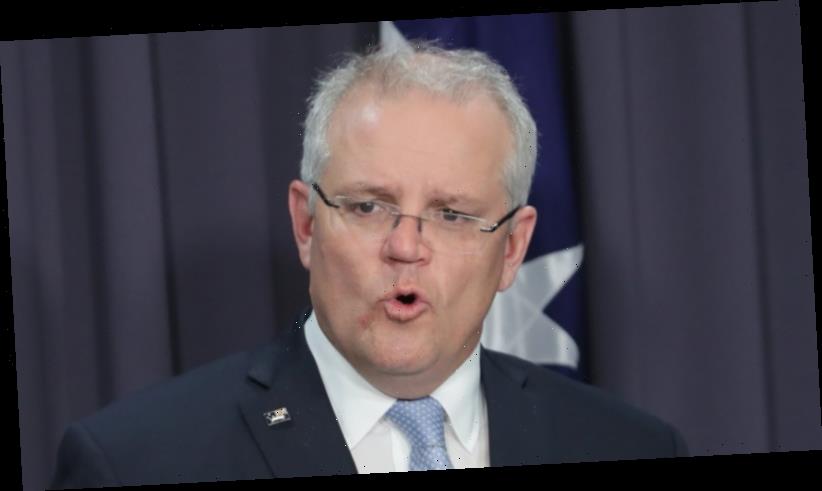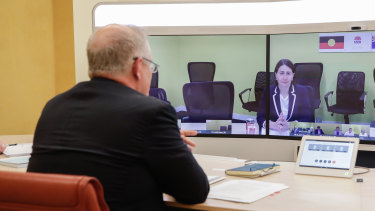Australians deserve better than the conflicting messages from state and federal governments about the scale of the community shutdown.
The obvious friction within the national cabinet does nothing to shore up confidence that Prime Minister Scott Morrison and the premiers can see out this coronavirus emergency.
Prime Minister Scott Morrison speaks with NSW Premier Gladys Berejiklian (on screen) during Sunday night’s national cabinet meeting to discuss COVID-19 from the teleprescence room of Parliament House in Canberra.Credit:Alex Ellinghausen
Companies and their staff were given an edict on Sunday night to close or curtail their operations in a way that is certain to put workers on the jobless queue.
This came after a shambolic day on Sunday when leaders engaged in thinking out loud before they met at 6.30pm to make a decision at the national cabinet meeting.
Australians have seen plenty of dysfunction in their federation over the years – clashes over hospitals or big road projects – but it has never looked as troubling, perhaps even dangerous, as it did on Sunday.
A blame game is now under way, with the arguments heavily influenced by political allegiance or leaning. Those who barrack for Morrison blame the states; those who prefer Labor blame the Prime Minister, who scraped home at the last election.
The national cabinet turns out to be like any other cabinet. It leaks and it splits.
That is what happened on Sunday when NSW Premier Gladys Berejiklian and Victorian Premier Daniel Andrews aired their calls for community shutdowns.
The two premiers forced Morrison to bring forward the national cabinet meeting from its scheduled time on Tuesday night.
Morrison agreed to the urgent meeting but was clearly reluctant to shut down so many parts of the economy. He pushed back and the result on Sunday night was a decision that did not go as far as Andrews had signalled hours earlier. Andrews said on Sunday he wanted a shutdown of everything except essential services, leading to a day of conjecture about what was essential.
On schools, the messages are all over the place. The commonwealth Chief Medical Officer, Brendan Murphy, says the health advice has not changed and schools should stay open.
Morrison makes an important point about education when he warns that a shutdown could mean children lose a year of schooling. Once closed, a school may not reopen for months.
Andrews used curious language when confirming on Monday morning that schools would close from Tuesday.
"We have taken the decision, and the Chief Health Officer of Victoria is completely comfortable and supportive of this, to bring forward the school holidays," he said. The Premier did not say the top health official advised the schools had to close. Complaints from teachers played a part too.
In Sydney, meanwhile, Berejiklian kept the schools open but told parents they could keep children home as they saw fit.
Morrison's economic message needed time to be heard on Sunday because it was fundamental to the task of shoring up confidence.
The fiscal stimulus should be a source of reassurance for Australians, not least those who are anxious about losing their jobs, because it included cash transfers to employers and a doubling of unemployment benefits to about $1100 a fortnight.
No sooner had the economic plan been revealed than word was leaking from state governments about the shutdowns. The federal and state messages worked against each other.
If the national cabinet is going to shut down business, why schedule the meeting for Sunday night? The timing was decided by the premiers but a Saturday meeting should have been arranged so there was an orderly way to issue clear guidance.
The response to this crisis has been full of mixed messages – not least whether to go to the football or not, whether to shake hands or not. The government advertising campaign has been too small and too gentle.
As the crowds in the pubs testify, many Australians need to be read the riot act.
The national cabinet needs to work more steadily. Disagreements are inevitable but decisions have to be made in a way that offers a sense of reassurance.
The structure of a federal and state cabinet remains the best way to co-ordinate action. Morrison was right to set it up. But if it cannot work smoothly when deciding community measures, it weakens confidence in its ability to confront the health challenges to come.
Sign up to our Coronavirus Update newsletter
Get our Coronavirus Update newsletter for the day’s crucial developments at a glance, the numbers you need to know and what our readers are saying. Sign up to The Sydney Morning Herald’s newsletter here and The Age’s here.
Source: Read Full Article

